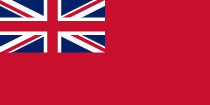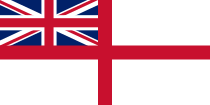
Back Vlag van die Verenigde Koninkryk Afrikaans Gaderscypefāna ANG علم المملكة المتحدة Arabic علم المملكه المتحده ARZ Bandera del Reinu Xuníu AST Birləşmiş Krallıq bayrağı Azerbaijani Kobér Britania Raya BAN Сцяг Вялікабрытаніі Byelorussian Сьцяг Вялікабрытаніі BE-X-OLD Национално знаме на Обединеното кралство Bulgarian
 | |
| Names | Union Jack, Union Flag, other names: The Britain; The British Flag; the Union; The Banner of the Union; the Great Union; the Flag of the Union; the Jack; The King's Jack; His Majesty’s Jack; Our Jack; the Jack Flag |
|---|---|
| Use | National flag |
| Proportion | 1:2 (commonly) and 3:5 |
| Adopted |
|
| Design | A combination of the crosses of SS Andrew, George, and Patrick |
 Variant flag of the United Kingdom of Great Britain and Northern Ireland | |
| Use | Civil ensign |
| Proportion | 1:2 |
| Design | A red flag with the Union Flag in the corner at the top of the flag pole. See Red Ensign. |
 Variant flag of the United Kingdom of Great Britain and Northern Ireland | |
| Use | Civil air ensign |
| Proportion | 1:2 |
| Design | A blue flag with the Union Flag in the corner at the top of the flag pole and a black cross in the centre. See Civil Air Ensign. |
 Variant flag of the United Kingdom of Great Britain and Northern Ireland | |
| Use | State ensign |
| Proportion | 1:2 |
| Design | A blue flag with the Union Flag in the corner at the top of the flag pole. See Blue Ensign. |
 Variant flag of the United Kingdom of Great Britain and Northern Ireland | |
| Use | Naval ensign |
| Proportion | 1:2 |
| Design | A white flag with the Union Flag in the corner at the top of the flag pole and a red cross in the centre. See White Ensign. |
 Variant flag of the United Kingdom of Great Britain and Northern Ireland | |
| Use | Air force ensign |
| Proportion | 1:2 |
| Design | A blue flag with the Union Flag in the corner at the top of the flag pole and the RAF roundel on the opposite side. |
The flag of the United Kingdom is the Union Flag or Union Jack. The Union Flag is the national flag of the United Kingdom. It has had the same design since the Act of Union 1800. The flag is made from the flags of the kingdoms of England, Scotland, and Ireland.
The common ratio that used by the government and other institutions are 1:2. There are no official ratios for the flag many from of the flag are correct. The college of arms recommends 2 versions of the flag's ratios: 1:2 and 3:5.[1][2]
The use of the flag started (with a different design) in 1606, after James VI and I became the first king of the whole of Great Britain in 1603. Between 1606 and 1801, the Union Flag's design was different to the present flag.[2] At that time, the Kingdom of Ireland was a separate kingdom. (Between the execution of Charles I and the Restoration of Charles II, there was no personal union between Scotland and England, so the Union Flag was not necessary.)[2] Scotland and England became the United Kingdom of Great Britain in 1707. Anne, Queen of Great Britain, chose the Union Flag as the flag of the new kingdom.[2] The Kingdom of great Britain and Ireland joined together in 1801. The use of the present British flag started then.[2]
The first Union Flag from 1603 combined the flag of Scotland with the flag of England. The flag of Scotland is a Saint Andrew's Cross because Saint Andrew is the patron saint of Scotland. The flag of England is Saint George's Cross because Saint George is the patron saint of England. When the present United Kingdom started in 1801, the Saint Patrick's Cross started to be a part of the Union Flag.[3] Saint Patrick's Cross was a flag representative of Ireland because Saint Patrick is the patron saint of Ireland. Saint Patrick's Cross is a red saltire (a diagonal cross) with a white background. The flag of Scotland is blue with a white saltire. The flag of England is white with a red horizontal cross. Together they make the Union Flag.[3]
The flag did not change as result of the independence of the Republic of Ireland.[2] The flag did not change when the United Kingdom's name changed from the "United Kingdom of Great Britain and Ireland" to the "United Kingdom of Great Britain and Northern Ireland". The flag does not contain anything that represents Wales. (In 1603, Wales had long been a part of the kingdom of England.) Some people want a new design because of this.
- ↑ "United Kingdom Flag | Free official image and info | UK Flag Registry". The Flag Institute. Retrieved 2021-05-01.
- ↑ 2.0 2.1 2.2 2.3 2.4 2.5 Bartram, Graham. "Union Flag: History". The Flag Institute. Retrieved 2021-04-30.
- ↑ 3.0 3.1 Cannon, John; Crowcroft, Robert (2015). "Union Jack". A Dictionary of British History (3rd online ed.). Oxford University Press. doi:10.1093/acref/9780191758027.001.0001. ISBN 978-0-19-175802-7.